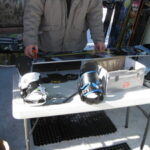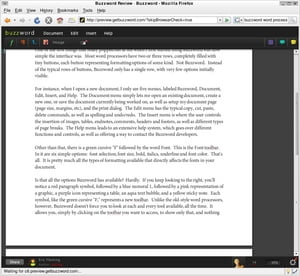If you have a printed document that needs to be bound, you have many choices. Some binding methods are quick and easy, while others more difficult and time-consuming. Most of these can be done at home; others may require a trip to a copy shop to use specialized equipment. Here are the eight most popular binding methods.
Staples
Quick, cheap, and easy, staples are by far the most common way to bind pages together. For the simplest documents, a single staple in the upper left corner may suffice. For others, three staples along one edge works well. I suggest five, though, to prevent annoying gaps when the document is opened. Another option is the saddle stapler, which allows pages to be folded in half to make a booklet that is then stapled on the fold.
Ring Binding
Another extremely common binding technique is to punch the papers with three holes and insert them into a three-ring binder. A major advantage of this system is the ease in which papers can be added, rearranged, and removed. Although binders can now be customized in many ways, this approach is still seen as somewhat unprofessional in its final appearance.
Comb Binding
Comb binding involves punching specially spaced rectangular holes in the paper and inserting a plastic spine to hold everything together. Most comb binding systems use 19 holes. The punching machines usually have the ability to open the spines so that pages can be inserted. This method is cheap and efficient once you spend the initial money on the machine – usually about $80-$100 for a basic model. Comb bound books open flat.
Wire-O Binding
Similar to comb binding, Wire-O binding (or simply “wire binding”) uses a double-looped wire spine instead of a plastic comb. If you choose 19-loop wire spines, you can use the same punch as you would use for comb binding.
Coil Binding
Coil or spiral binding is very commonly seen on commercial notebooks. A spiral of wire or stiff plastic is thread through punched holes, and the ends are crimped to prevent it from escaping. A major advantage of this kind of binding is that the resulting document can be opened not only flat, but brought around 360 degrees. To use coil binding, you must either have it done professionally or purchase a special machine to punch the holes. You must also buy the correct type of wire for the holes, as several different kinds of punches are available.
VeloBind
The basic VeloBind system is a permanent binding method, which can be an advantage for certain types of documents. Holes are punched through the paper and tines, affixed to a plastic strip, are inserted through the document. Then the tines are threaded through a second plastic strip. A machine presses and melts the tips of the tines. There is another variety of VeloBind that does not melt the tines, thereby allowing disassembly. With either option, books made in this way will not open or lie flat.
Thermal Binding
In thermal binding, pages are stacked and a strip of glue is applied to the spine. Then the spine is inserted into a machine that melts the glue and binds the pages together. This type of binding will usually open flat. It is not suited for glossy papers; the glue does not adhere well and pages will often fall out. Thermal binding may not be the ideal choice for books that will receive heavy use as it may not stand up to the abuse.
Sewn or Stitched Binding
This is a time-consuming choice but the results can be very attractive. Folded papers are gathered together and sewn down the spine. Sewn binding works best for relatively short documents like pamphlets and handmade booklets, and even then is better when only a few copies are needed.





